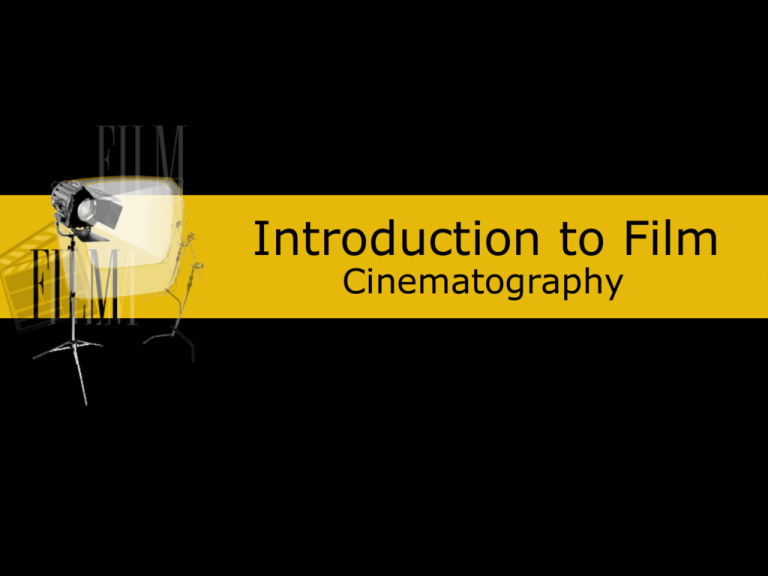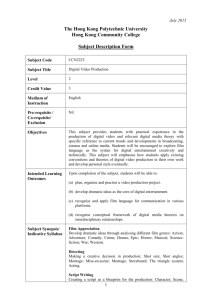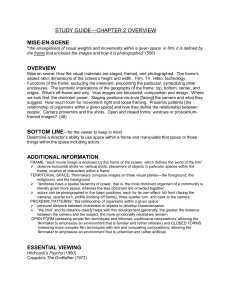Intro to Film - Hinsdale South High School
advertisement

Introduction to Film Cinematography Cinematography Cinematography: "writing in movement” Everything that has to do with cameras and lenses, with film/film stock (and its digital equivalents), exposure and processing of film/digital images. Cinematography Mise-en-scene What is filmed Set Design Color Lighting Actor’s Performances Diegetic Sound Cinematography How it is filmed Framing Aspect Ratio Film Stock Camera Elements Camera Camera Camera Camera Exposure Angle Movement Position Lens Cinematography Other Issues Digital Cinematography Visual Special Effects Often done in post-production (esp. digital effects). Lighting Computer Generated Imagery (CGI) has brought changes in Cinematography, which was traditionally based on chemical/photographic images and effects. Since it is part of “what is filmed,” it is often seen as part of a film’s mise-en-scene. However, the cinematographer has significant input into lighting decisions. Framing As with lighting, framing involves the director and cinematographer. Framing Angle, level, and distance of framing each shot Offscreen space versus onsceen space Framing Extreme Wide Shot Very Wide Shot Framing Wide Shot Mid Shot Framing Medium Close Up Close Up Framing Extreme Close Up Cut-In Camera Angle The angle between the camera and the subject. Straight-on (Eye-level) angle High-angle Low-angle Low-angle Bird’s Eye Point of View The Lady in the Lake 1947 Detective film Shot entirely from main character's point of view Slanted or Canted angle (Dutch tilt) Slanted or Canted angle (Dutch tilt) Slanted or Canted angle (Dutch tilt) Height of Camera Tokyo Story (1953) Yasujiro Ozu Aspect Ratio Ratio of screen width to height Classical Hollywood ratio (1.33:1) Widescreen ratios (1.85:1, 2.35:1) Video conversion Pan-and-scan Letterbox Aspect Ratio Rules of the Game, Jean Renoir, 1939 1.33:1 (4 to 3) Aliens, James Cameron, 1986 1.85:1 Rebel Without A Cause, Nicholas Ray, 1955 2.35:1 (Cinemascope) Aspect Ratio Converting from film to TV. 2.2 to 1 Pan & Scan; 1.33 to 1 Film Stock Selection enables cinematographer to control: Color reproduction Light sensitivity Contrast levels Sharpness Grain and resolution Singin’ in the Rain Technicolor Film Stock Film Stock Other Types Kodachrome Kinemacolor Cinecolor 35mm 70mm IMAX Film stock deteriorates over time Camera Lens Focal Length The distance from the center of the lens to the point at which the light rays meet in sharp focus. This length determines perspective relations and depth cues on the flat screen surface. Normal lens: 35-50mm Camera Lens Wide Angle Short focal length (35 mm or less) which produces a wider angle of view Effect: distorting straight lines, exaggerating depth Camera Lens Telephoto Lens Lens with a long focal length (75mm or more). Effect: collapse depth cues by enlarging distant planes and making them seem close to the foreground planes. Camera Lens Zoom lens Lens with a focal length that can be changed during a shot. Shift to telephoto range magnifies the image and flattens the space Shift to wide-angle increases depth cues and demagnifies the background. Depth of Field The range of distance within which objects can be photographed and remain in sharp focus. Short focal length has greater depth of field. Long focal length reduces depth of field. Camera Movement Pan Tilt Rotates horizontally, side to side Vertical pivot, up and down Dolly, tracking, or traveling shots Crane (and boom or jib) shots Hand-held and steadicam shots Camera Movement Dolly, Tracking, Traveling shots: all basically the same. “Tracking shot” came from the “tracks” that dollies moved on. Traveling shot is generally reserved for movements taken from a vehicle. Camera Movement Boom/jib shots Camera mounted on counterweighted boom; some booms can also telescope in or out. Can use for combinations of pans & tilts, horizontal, vertical or diagonal moves. Crane shots Shots look the same as boom shot, but often motorized or with hydraulics for movement. Camera Movement Hand-held shots Can pan or tilt or track Hand-held movement is obviously “unsteady”--which is how we know it’s a hand-held shot. Steadicam A device which dampens unsteadiness, producing a relatively smooth movement, even when walking or running. Steadicam first used in Rocky (1976) Cinematography Putting it all together with story boarding. Example: The Lord of the Rings






